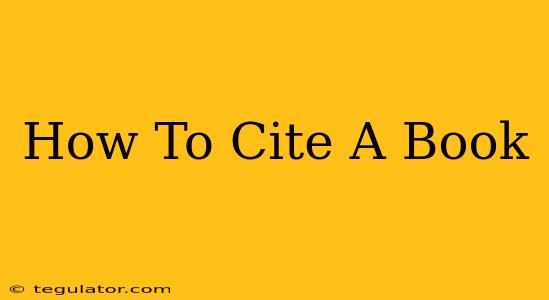Citing your sources correctly is crucial for academic integrity and avoiding plagiarism. Knowing how to cite a book accurately, regardless of the citation style, is a fundamental skill for students and researchers. This guide will walk you through the process, covering the most common citation styles. We'll break down the essential elements and provide examples to make citing your sources simple and straightforward.
Understanding Citation Styles
Different academic disciplines and institutions prefer various citation styles. The most popular styles include:
- MLA (Modern Language Association): Commonly used in the humanities, such as literature, languages, and cultural studies.
- APA (American Psychological Association): Widely used in social sciences, psychology, education, and business.
- Chicago/Turabian: Offers two styles – notes and bibliography (more common in humanities) and author-date (used in social sciences).
- IEEE (Institute of Electrical and Electronics Engineers): Primarily used in engineering, computer science, and technology fields.
Choosing the correct style is critical. Always check your assignment guidelines or consult with your professor to confirm the required style. Using the wrong style can lead to point deductions.
Essential Elements for Book Citations
Regardless of the citation style, several key pieces of information are needed to create a complete book citation:
- Author's Name: Include the last name followed by a comma and the first initial (or full first name if preferred). If there are multiple authors, list them in the order they appear on the title page, separated by commas.
- Book Title: Italicize the book title.
- Publisher: This is usually found on the copyright page.
- Publication Date: Typically found on the copyright page; use the year of publication.
- Edition (if applicable): Specify if it's a second edition, revised edition, etc.
- Location (City and State): For many styles, this is required; some styles only require the city.
Examples of Book Citations in Different Styles
Let's use the following hypothetical book as an example:
Book: The History of Coffee by Anna Smith, published in 2023 by Acme Books in New York, NY.
MLA Citation:
Smith, Anna. The History of Coffee. Acme Books, 2023.
APA Citation:
Smith, A. (2023). The History of Coffee. Acme Books.
Chicago/Turabian (Author-Date):
Smith, Anna. 2023. The History of Coffee. New York: Acme Books.
Chicago/Turabian (Notes and Bibliography):
Note: Anna Smith, The History of Coffee (New York: Acme Books, 2023), 12.
Bibliography: Smith, Anna. The History of Coffee. New York: Acme Books, 2023.
Tips for Accurate Book Citations
- Double-check your information: Always verify the information against the book itself to ensure accuracy.
- Use a citation management tool: Tools like Zotero, Mendeley, or EndNote can significantly simplify the citation process and help maintain consistency.
- Consult style guides: For detailed guidelines and specific examples, refer to the official style manuals (MLA Handbook, Publication Manual of the American Psychological Association, etc.).
- Proofread carefully: Before submitting your work, meticulously proofread all your citations for errors.
Beyond the Basics: Handling More Complex Situations
The examples above cover basic book citations. However, you may encounter more complex scenarios, such as:
- Books with multiple authors or editors: Citation styles have specific rules for handling multiple authors; generally, list all authors if there are three or fewer; if more, sometimes only the first author is listed, followed by "et al."
- Edited books: Citations for edited books differ from those for single-author books. You will need to cite the editor(s) instead of the author(s).
- E-books: Citation styles often have specific formatting for e-books, including the URL or DOI (Digital Object Identifier).
Mastering book citations requires attention to detail and familiarity with the chosen style. By following these guidelines and practicing regularly, you can effectively and accurately cite your sources, ensuring academic integrity in your work. Remember to always prioritize accuracy and consistency.

